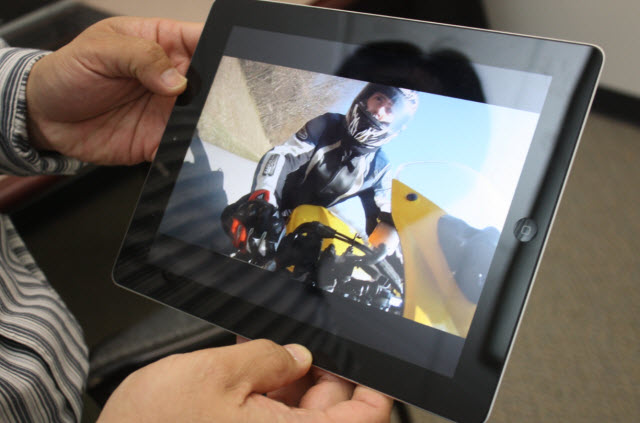 When you’re skiing down a mountain, you can actually share the viewing experience with your friends these days by attaching a high-definition wireless camera to your goggles. One of the companies making that possible is Ambarella, a camera chip maker that is announcing a new wireless camera developer kit today to make it easier to create a new generation of these sports cameras.
When you’re skiing down a mountain, you can actually share the viewing experience with your friends these days by attaching a high-definition wireless camera to your goggles. One of the companies making that possible is Ambarella, a camera chip maker that is announcing a new wireless camera developer kit today to make it easier to create a new generation of these sports cameras.
The Santa Clara, Calif.-based company has helped usher in the revolution in high-definition video and still cameras that use very little power and so can fit into smaller packages than older digital cameras and camcorders. And by adding wireless capability from Qualcomm Atheros, Ambarella makes it easy to create mini cameras that can fit on your head and pass images to a smartphone, which can then be used to either control the direction of the camera or stream the images over the air to your friends. This kind of technology shows that a smartphone can work as a complement to a camera, rather than eliminate the need for a camera. Ambarella will display the A7L Android-based technology next week at the Consumer Electronics Show in Las Vegas.
 Ambarella enables a new class of wireless HD cameras with smartphone control, viewing and social network video sharing. Camera makers can create rugged packages around these components so they can be strapped on when someone is skiing, riding a motorcycle, or even diving under water.
Ambarella enables a new class of wireless HD cameras with smartphone control, viewing and social network video sharing. Camera makers can create rugged packages around these components so they can be strapped on when someone is skiing, riding a motorcycle, or even diving under water.
“The solution in these cases is to move the controls to the smartphone,” said Chris Day (pictured), vice president of marketing and business development at Ambarella, in an interview. “The camera is no longer going to be a stand-alone device.”
While Ambarella makes the chips for such devices, camera makers such as Contour create the actual video and still cameras for targeted consumers. With the new Ambarella technology, users will be able to get much better control of their cameras using a touchscreen on a smartphone or tablet. Ambarella focused on the imaging technology, while Qualcomm Atheros provided wireless expertise.
Today’s popular sports cameras have to perform in rugged outdoor conditions and require a camera to be mounted where it’s impractical to view a preview screen.
In an improvement on that, Ambarella enables cameras that can stream the video from the camera to the smartphone, where the display shows the view from the camera and lets a user adjust the camera direction. For still cameras, users can use a smartphone to adjust a camera for a family portrait while remaining in the shot. Or they can use a camera and a wireless remote smartphone to do stealth wildlife photography, without scaring away animals.
The smartphone can also be used to playback the recorded video, stream live video action to popular Internet broadcast websites, such as Qik and Ustream, or upload photos or video files to Facebook and YouTube. The software development kit is available for Ambarella’s A7L SoC chip family, providing full 1080p HD video at 60 frames per second and very low power consumption.
Ambarella filed to go public in June 2011 but hasn’t taken any action on that filing. The company has more than 400 employees now, including 200 in Taiwan. It was recently voted the most-respected private semiconductor company of 2011 in a vote by peers. Aside from camcorders and digital cameras, Ambarella’s chips are used in broadcast infrastructure, video networking, and surveillance. Since 2006, the company has delivered five generations of imaging chips.
The latest A7L chips run Android and support a variety of features, from cloud services to full HD playback. They use there ARM microprocessor cores in a single chip. Multiple products using these chips and the wireless technology are expected to debut in 2012, Day said.

